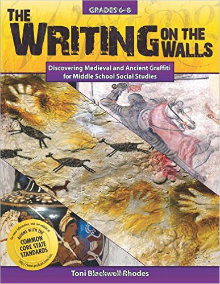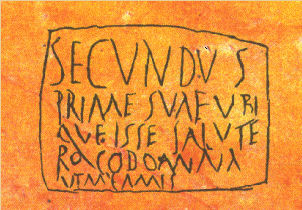History Hook: Ancient Writing on the Walls
The Writing on the Walls: Discovering Medieval and Ancient Graffiti for Middle School Social Studies
By Toni Blackwell Rhodes
(Prufrock Press, 2015 – Learn more)

Methods in teaching history have changed. Before it was memorizing facts and dates. Now it has evolved, using strategies from language arts and reading, to encompass more complexity.
History is also a subject that invites hands-on learning, with students actually employing some of the methods used by historians and geographers. Hence, new programs such as Reading Like an Historian are gaining in popularity. This approach invites students to use primary sources to analyze and draw conclusions – the same methods employed by professional scholars.

The book delves into three time periods and settings:
- Medieval British churches
- Buried remains of Pompeii during the Roman Empire
- Pottery and walls of the Agora or central marketplace of Athens
Even when a written language had been developed, most of the people in ancient times couldn’t read or write. So pictures were used to convey messages. Graffiti took the form of news bulletins, election notices, love poems, property tags and warnings. It was even used for letter practice and as a simple way of saying “I was here.” These messages were left on walls, pillars, pottery shards and tombs. Lack of paper was probably another reason that so many people chose this mode of communication.
More about the book
After a brief intro, the author starts every chapter with a short history of the time period. For example, in the destruction of Pompeii the author states that Pliny the Younger was an eyewitness to the eruption and wrote letters detailing the event.
He wrote: “Fires erupted from different points all over Mount Vesuvius and the towering flames gave off a light whose brightness and clarity contrasted with the shadows of the night….People tied cushions on their heads with pieces of sheet; this was their only protection against falling debris.” (Rhodes, p31) In this quote, the students can not only get a vivid picture of what is happening, but also develop empathy for the situation as they talk about what was left behind.

“Secundus says hello to his Prima, wherever she is. I ask, my mistress, that you love me.” (Pompeii)
Author Toni Rhodes gives countless examples of different places where graffiti is found. They range from the bronze and copper coins in Greece, to depictions of monks writing in illustrated manuscripts in England, to love notes on the walls in Italy.
She also includes websites and reading lists, as well as extra activities at the end of each chapter. The ones for the medieval times are designing a versal (a large decorated capital letter), a medieval board game, and a gravestone rubbing.
Even though this book only covers three time periods, I feel the idea can extend to many more. Graffiti has been found in the deep recesses of ancient Egyptian tombs and has been spray painted on our modern buildings. The ubiquitous Kilroy was here is also a form of graffiti as is the writing of American GI’s scribbled on the underside of their bunks on their way to Vietnam.
I would suggest that teachers use the ideas that are here, then take them into other times and places. It’s a book whose time has come.
Joanne Bell is a middle school teacher at St. Joseph Elementary School in Missouri. She currently teaches social studies to sixth and seventh graders, but has spent most of her 32 years in the early elementary grades.


































